Octet rule Study guides, Class notes & Summaries
Looking for the best study guides, study notes and summaries about Octet rule? On this page you'll find 426 study documents about Octet rule.
Page 3 out of 426 results
Sort by
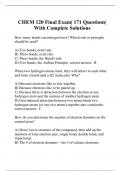
-
CHEM 120 Final Exam| 171 Questions| With Complete Solutions
- Exam (elaborations) • 47 pages • 2023
- Available in package deal
-
- $15.99
- + learn more
How many bonds can nitrogen have? Which rule or principle should be used? A) Five bonds; octet rule. B) Three bonds; octet rule. C) Three bonds; the Hund's rule. D) Five bonds; the Aufbau Principle. correct answer: B When two hydrogen atoms meet, they will attract to each other and form a bond (and a H2 molecule). Why? A) Because electrons like to stay together. B) Because electrons like to be paired up. C) Because there is attraction between the electron in one hydrogen atom an...
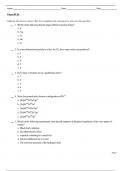
-
Test Bank for Chemical Principles, 8th Edition by Peter Atkins
- Exam (elaborations) • 558 pages • 2024
-
- $39.49
- + learn more
Test Bank for Chemical Principles: The Quest for Insight 8e 8th Edition by Peter Atkins; Loretta Jones; Leroy Laverman; Kelley Young; James Patterson. Full Chapters are included (Focus 1 to Focus 10 are included) Focus 1: Atoms 1A Investigating atoms 1B Quantum theory 1C Wavefunctions and energy levels 1D The hydrogen atom 1E Many-electron atoms 1F Periodicity Focus 2: Bonds Between Atoms 2A Ionic bonding 2B Covalent bonding 2C Beyond the octet rule 2D The properties of bonds 2...
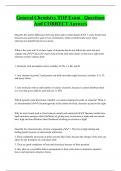
-
General Chemistry TOP Exam Questions And CORRECT Answers
- Exam (elaborations) • 65 pages • 2024
-
- $9.99
- + learn more
Describe the atomic differences between Ionic and Covalent bonds. 1. Ionic bonds form between ions and involve gain or loss of electrons, while covalent bonds occur when electrons are shared between two atoms What is the octet rule? List three types of elements that do not follow the octet rule and explain why. Octet rule=atoms tend to bond with other atoms so they have eight outer electrons in their valence shell 1. Elements with incomplete octets, includes: H, He, Li, Be, and B. 2. ...
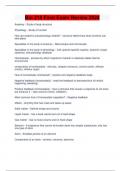
-
Bio 210 Final Exam Review 2024
- Exam (elaborations) • 21 pages • 2024
-
- $12.99
- + learn more
Anatomy - Study of body structure Physiology - Study of function How are anatomy and physiology related? - structure determines what functions can take place Specialties in the study of anatomy - Macroscopic and microscopic Specialties in the study of physiology - Cell, special (specific organs), systemic (organ systems), and pathology (disease) Homeostasis - process by which organisms maintain a relatively stable internal environment components of homeostasis - stimulus, recep...
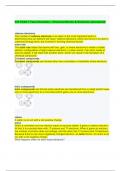
-
ATI TEAS 7 Test Chemistry - Chemical Bonds & Solutions (Answered)
- Exam (elaborations) • 5 pages • 2024
-
- $9.99
- + learn more
ATI TEAS 7 Test Chemistry - Chemical Bonds & Solutions (Answered) valence electrons The number of valence electrons in an atom is the most important factor in determining how an element will react. Valence electrons, which are found in an atom’s outermost energy level, are involved in forming chemical bonds. octet rule The octet rule states that atoms will lose, gain, or share electrons to obtain a stable electron configuration of eight valence electrons. In other words, if an atom nee...
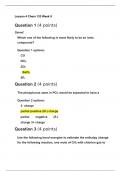
-
CHEM133 Week 9 Lesson 4 Quiz
- Exam (elaborations) • 12 pages • 2023
- Available in package deal
-
- $29.99
- + learn more
1. Question: Which one of the following is most likely to be an ionic compound? 2. Question: The phosphorus atom in PCl3 would be expected to have a 3. Question: The phosphorus atom in PCl3 would be expected to have a give CH3Cl and hydrogen chloride. 4. Question: How many of the following molecules have no dipole moment? 5. Question: Atoms having equal or nearly equal electronegativities are expected to form 6. Question: Element A has an electronegativity of 0.8 and element B has an electr...

-
CHEM 103 FINAL EXAM QUESTIONS AND ANSWERS 2024
- Exam (elaborations) • 35 pages • 2024
- Available in package deal
-
- $13.49
- + learn more
Lewis Structures - represents the transfer or the sharing of electrons in chemical bonds octet rule - EVERY ATOM WANTS 8 ELECTRONS IN THEIR OUTERSHELL ionic bonding - chemical bond formed through the transfer of one or more electrons from one atom or group of atoms to another group EX : NaBr metals - give nonmetals - take oxidation number - the superscript indicating the charge on an ion ion - atom with either positive or negative charge binary compound - compounds in wh...
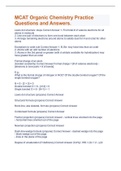
-
MCAT Organic Chemistry Practice Questions and Answers.
- Exam (elaborations) • 50 pages • 2023
-
- $8.99
- + learn more
Lewis dot structure: steps Correct Answer 1. Find total # of valence electrons for all atoms in molecule 2. Use one pair of electrons to form one bond between each atom 3. Arrange remaining electrons around atoms to satisfy duet for H and octet for other atoms Exceptions to octet rule Correct Answer 1. B, Be: may have less than an octet 2. Atoms with an odd number of electrons 3. Atoms in the 3rd period or greater (with d orbitals available for hybridization) may have greater than an octe...
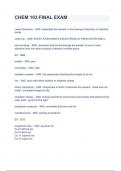
-
CHEM 103 FINAL EXAM QUESTIONS AND ANSWERS ALL VERIFIED
- Exam (elaborations) • 24 pages • 2023
-
- $9.49
- + learn more
CHEM 103 FINAL EXAM QUESTIONS AND ANSWERS ALL VERIFIED Lewis Structures - ANS represents the transfer or the sharing of electrons in chemical bonds octet rule - ANS EVERY ATOM WANTS 8 ELECTRONS IN THEIR OUTER SHELL ionic bonding - ANS chemical bond formed through the transfer of one or more electrons from one atom or group of atoms to another group EX : NaBr metals - ANS give nonmetals - ANS take oxidation number - ANS the superscript indicating the charge on an i...
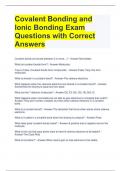
-
Covalent Bonding and Ionic Bonding Exam Questions with Correct Answers
- Exam (elaborations) • 3 pages • 2023
- Available in package deal
-
- $13.99
- + learn more
Covalent Bonding and Ionic Bonding Exam Questions with Correct Answers Covalent bonds are bonds between 2 or more....? - Answer-Nonmetals. What do covalent bonds form? - Answer-Molecules. True or False. Covalent bonds form compounds. - Answer-False, they only form molecules. What is shared in a covalent bond? - Answer-The valence electrons. What happens when the valences electrons are shared in a covalent bond? - Answer-Sometimes the sharing is equal and non-polar. What are th...

How did he do that? By selling his study resources on Stuvia. Try it yourself! Discover all about earning on Stuvia


